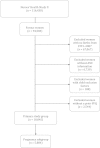Maternal dietary fat intake in association with autism spectrum disorders
- PMID: 23813699
- PMCID: PMC3988447
- DOI: 10.1093/aje/kws433
Maternal dietary fat intake in association with autism spectrum disorders
Abstract
Our goal in this study was to determine whether maternal fat intake before or during pregnancy was associated with risk of autism spectrum disorder (ASD) in the offspring. Our primary analysis included 317 mothers who reported a child with ASD and 17,728 comparison mothers from the Nurses' Health Study II (index births in 1991-2007). Dietary information was collected prospectively through a validated food frequency questionnaire. Binomial regression was used to estimate crude and adjusted risk ratios. Maternal intake of linoleic acid was significantly inversely associated with ASD risk in offspring, corresponding to a 34% reduction in risk in the highest versus lowest quartiles of intake. Mothers in the lowest 5% of ω-3 fatty acid intake had a significant increase in offspring ASD risk as compared with the remaining distribution (risk ratio = 1.53, 95% confidence interval: 1.00, 2.32); this association was also seen in the subgroup of women (86 cases and 5,798 noncases) for whom dietary information during pregnancy was available (risk ratio = 2.42, 95% confidence interval: 1.19, 4.91). Thus, variations in intake of polyunsaturated fats within the range commonly observed among US women could affect fetal brain development and ASD risk. Because the number of women with diet assessed during pregnancy was small, however, these results should be interpreted cautiously.
Keywords: autism; dietary fat; linoleic acid; polyunsaturated fatty acids; ω-3 fatty acids; ω-6 fatty acids.
Figures


Similar articles
-
Maternal fat intake during pregnancy and behavioral problems in 5-y-old Japanese children.Nutrition. 2018 Jun;50:91-96. doi: 10.1016/j.nut.2017.12.001. Epub 2018 Feb 2. Nutrition. 2018. PMID: 29549849
-
Maternal meat and fat consumption during pregnancy and suspected atopic eczema in Japanese infants aged 3-4 months: the Osaka Maternal and Child Health Study.Pediatr Allergy Immunol. 2010 Feb;21(1 Pt 1):38-46. doi: 10.1111/j.1399-3038.2009.00897.x. Epub 2009 Jun 23. Pediatr Allergy Immunol. 2010. PMID: 19552790
-
Fish and fat intake and prevalence of allergic rhinitis in Japanese females: the Osaka Maternal and Child Health Study.J Am Coll Nutr. 2007 Jun;26(3):279-87. doi: 10.1080/07315724.2007.10719612. J Am Coll Nutr. 2007. PMID: 17634174
-
Maternal lifestyle and environmental risk factors for autism spectrum disorders.Int J Epidemiol. 2014 Apr;43(2):443-64. doi: 10.1093/ije/dyt282. Epub 2014 Feb 11. Int J Epidemiol. 2014. PMID: 24518932 Free PMC article. Review.
-
Maternal Dietary Factors and the Risk of Autism Spectrum Disorders: A Systematic Review of Existing Evidence.Autism Res. 2020 Oct;13(10):1634-1658. doi: 10.1002/aur.2402. Epub 2020 Oct 5. Autism Res. 2020. PMID: 33015977 Free PMC article.
Cited by
-
Developmental vitamin D and autism spectrum disorders: findings from the Stockholm Youth Cohort.Mol Psychiatry. 2021 May;26(5):1578-1588. doi: 10.1038/s41380-019-0578-y. Epub 2019 Nov 6. Mol Psychiatry. 2021. PMID: 31695167 Free PMC article.
-
Maternal Dietary Patterns during Pregnancy and Child Autism-Related Traits: Results from Two US Cohorts.Nutrients. 2022 Jun 30;14(13):2729. doi: 10.3390/nu14132729. Nutrients. 2022. PMID: 35807909 Free PMC article.
-
Prenatal Vitamins and the Risk of Offspring Autism Spectrum Disorder: Systematic Review and Meta-Analysis.Nutrients. 2021 Jul 26;13(8):2558. doi: 10.3390/nu13082558. Nutrients. 2021. PMID: 34444717 Free PMC article.
-
Maternal obesity and neurodevelopmental and psychiatric disorders in offspring.Prenat Diagn. 2017 Jan;37(1):95-110. doi: 10.1002/pd.4932. Epub 2016 Nov 7. Prenat Diagn. 2017. PMID: 27684946 Free PMC article. Review.
-
Autism, Gastrointestinal Symptoms and Modulation of Gut Microbiota by Nutritional Interventions.Nutrients. 2019 Nov 18;11(11):2812. doi: 10.3390/nu11112812. Nutrients. 2019. PMID: 31752095 Free PMC article. Review.
References
-
- Miles JH. Autism spectrum disorders—a genetics review. Genet Med. 2011;13(4):278–294. - PubMed
-
- Newschaffer CJ, Croen LA, Daniels J, et al. The epidemiology of autism spectrum disorders. Annu Rev Public Health. 2007;28:235–258. - PubMed
-
- Acosta MT, Pearl PL. Imaging data in autism: from structure to malfunction. Semin Pediatr Neurol. 2004;11:205–213. - PubMed
-
- Amaral DG, Schumann CM, Nordahl CW. Neuroanatomy of autism. Trends Neurosci. 2008;31(3):137–145. - PubMed
MeSH terms
Substances
Grants and funding
LinkOut - more resources
Full Text Sources
Other Literature Sources

